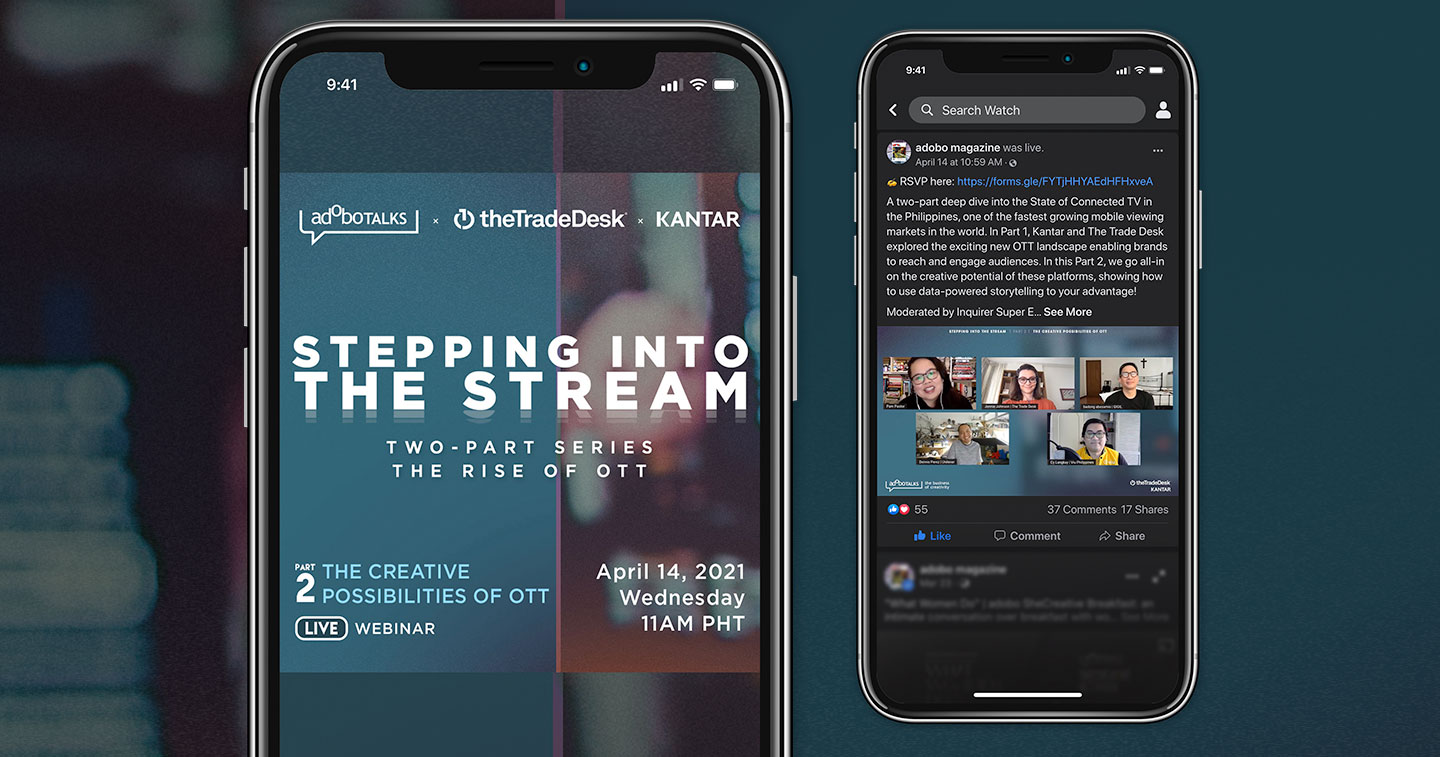MANILA, PHILIPPINES —On April 14, adobo Magazine, in association with The Trade Desk, presented Into the Stream Part 2, an adoboTalks session dedicated to exploring the creative possibilities for brands in the world of over the top (OTT) media. Having previously defined OTT as premium scripted streaming content (not to be confused with user-generated content) in an earlier session to cover the “why”, Part 2 focused on the “how”.
Inquirer Editor Pam Pastor steered the panel discussion, which featured Creative Guild Hall of Famer and Gigil founding partner Badong Abesamis, Viu Philippines Head of 360 Partnerships Cy Langkay to represent the OTT side, Unilever Philippines Country Media Director and former IMMAP chair Dennis Perez, and The Trade Desk’s Sr. Director for Marketing – SEANZ, Jennie Johnson.
Opening up the session, Johnson stressed creativity’s importance to The Trade Desk’s offering of programmatic advertising: “We can talk about the fact that one in five OTT viewers no longer watches TV, but that’s not gonna win hearts and minds. What’s gonna win hearts and minds is beautiful advertising; all of the sight, sound, and emotion of television, plus the new technology, plus the data storytelling plus the amazing new ad formats. And that, to me, is what’s really going to drive advertiser adoption of this very, very exciting, growing new channel.”
With OTT being a digital medium, a large part of the excitement stems from being able to garner real-time, data-driven insights to influence, not just the content being viewed, but the ads that accompany them. Thus, brands have increasingly begun working directly with platforms to ensure maximum effectiveness for their ads. In the case of VIU, this has actually resulted in platform-specific materials for their predominantly Korean-drama-powered fanbase.
“Currently, 20% of our ads are specifically made for our platform’s audience,” said Langkay. Whether it was something as simple as contextual ads integrating products with clips from popular shows, to AI that identifies key moments during the show and pairing it with appropriate products. Langkay used a clip from “My Love From the Star” as an example, wherein an Enervon multivitamins pop-up is displayed upon footage of series lead Kim Soo-hyun when his character suffers from a fever. Overall, VIU’s integration of ads has been a success, with the platform. As per Langkay, “This year, we’re actually expecting over 50% of the ads to be customized for our platform.”
With the shuttering of ABS-CBN’s main broadcast division, and the ongoing community lockdowns, the viability of OTT rose to an all-time high over the last 12 months, as Filipinos flocked online for their entertainment. Mainstream audiences’ shift to digital has brought with it an expectation for advertisers to know their audiences – gone are the days of presenting material at specific timeslots with hopes that target demographics would have their tv’s on at just the right moment. However, the ability of OTT to reach specific audiences on their own terms wasn’t an excuse for brands to forego creativity in their approach.
“At the end of the day, our objective as marketers is basically to communicate to people that we want to serve, and if we are not able to communicate, then we’re not doing our jobs,” said Perez. “OTT is a connected screen. And if we don’t leverage, the data that comes with that screen, then it’s just basically synonymous and one-way. So data is very, very important in unleashing creativity. One way is to really look into the viewer pattern and behavior to know what really resonates with your consumer. For example, what contexts do K-drama fans really resonate towards? That could actually inform your campaign and your creative on what angle or idea you should actually take in order to talk to them better in the future.”
Perez illustrated his point with the story of “Free to Love”, an execution for Close-Up toothpaste wherein data was used to specifically target LGBTQIA advocates by tying up with popular program, Hello Stranger. “So because of that, we partnered and created a lot of, stories and integrated them into LGBTQIA OTT content. And because of that, we were able to garner a lot of talkability around Close-Up and the overall “Free To Love” campaign.” For Perez, the possibilities for brands on OTT , freed from the constraints of timeslots, block times, are practically limitless. Where once, Knorr would have been limited to, say, a 30-second ad or segment on a cooking program, Unilever recently leveraged online platforms and people’s love of travel to create an episodic regional cooking show for the brand where viewers were able to download relevant recipes in mid-show.
Speaking as one of the creative minds behind last year’s massively viral RC Cola campaign and numerous other unforgettable, award-wining executions, Abesamis put things in perspective by stating, “Principles don’t change, but practices to do. With the digital explosion, with the plethora of technologies, channels have evolved, new channels have emerged. But the principle of an idea, unleashing the power of a channel -or a platform- remains the same. The idea has the power to maximize the full potential of a channel for clients’ business purposes. And that is what we need to pursue – whether it’s ATL, or digital, or OTT, it has to be entertainment. Because before material can be shareable, it first has to be noticed – people need to be aware of the brand.”
With a recent Kantar study showing that OTT usage will only increase, the question most brands should be answering isn’t so much if they will get their brands online in order to accomplish their business objectives, but when. Furthermore, rather than just transposing tv materials onto OTT, however, brands need to be clear with regard to the KPI’s they hope to achieve; as Abesamis rightly pointed out, for advertisers, awareness was meaningless without engagement.
After all, said Abesamis, speaking of brands on OTT, alongside premium paid content, “When we’re actually pitted against the world’s best content creators on digital, we have to ask ourselves -as people who live on these channels- is our content any more interesting, then?
For more on how to make the most creative use of OTT, you can catch the entire Into the Stream webinar here.








